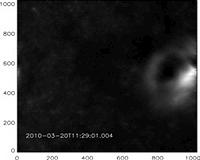 |
London, UK (SPX) Apr 25, 2011 So great is the wealth of data about the Sun now being sent back by space missions such as SOHO, STEREO and the Solar Dynamics Observatory (SDO) that scientists back on Earth can struggle to keep pace. To combat this data overload, scientists from the Visual Computer Centre at Bradford University are developing advanced imaging tools to help scientists visualise what's happening at the Sun, make sense of the data and predict the extreme solar activities that could affect our life here on Earth. Dr Rami Qahwaji will present the tools at the RAS National Astronomy Meeting at Llandudno. "These techniques are very important," said Qahwaji. "We are now able to process images on the ground so that the resolution is double that of the source images. Most satellites are limited by the amount of data that they can store and download. The ability to turn medium resolution images into high resolution in the lab means that satellites can take smaller images but more frequently, which will help with real-time monitoring of the Sun and predicting space weather. It also means that scientists can zoom in on the features that interest them, without downloading huge files. There is lot of potential for this technology. For example, it can help overcome small information loss caused by noise and can be used to generate high-definition 3D images." In addition to enhancing image resolution, the Bradford group has been developing 2- and 3-dimensional visualisation tools to help scientists understand the complex processes that drive solar activity. By processing multiple of solar images, they have created automated maps that summarise solar activity over an entire solar rotaion and models of magnetic field lines, generating 3-D visualisations of magnetic loop locations on the Sun's rotating globe. "This is the first time that SDO data has been used to create these synoptic maps and we have also created the first automated 3-D model of magnetic loops," said Qahwaji. "As well as being a useful tool for scientists, we hope that the public will find the 3-D model an interesting way of finding out what's happening on the Sun." The group is now collaborating with Trinity College Dublin on the development of a new flares predictions system called SMART-ASAP. This computerised system analyses recent images to extract physical properties from solar magnetic features that are analysed further using artificial intelligence techniques to predict whether extreme solar activities will occur. "Extreme solar activities, such as flares, can affect our life on Earth since we rely more and more on space-based communication and extended power distribution systems, both of which are vulnerable to such activities. The satellite and electrical power industries generate hundreds of billions of dollars in annual revenue and, if we are to protect these assets, we need accurate solar weather forecasting," said Qahwaji.
Share This Article With Planet Earth
Related Links Royal Astronomical Society Solar Science News at SpaceDaily
 Scientists See Solar Outburst In Exquisite Detail
Scientists See Solar Outburst In Exquisite DetailLondon, UK (SPX) Apr 20, 2011 The largest disturbances to the Earth's geomagnetic environment occur when it is buffeted by solar material hurled in our direction by explosive changes in the Sun's atmosphere. These Coronal Mass Ejections or CMEs contain approximately a billion tonnes of ionized gas or plasma and can have a dramatic and damaging impact on everything from satellites to power grids. Now a team of scientist ... read more |
|
| The content herein, unless otherwise known to be public domain, are Copyright 1995-2010 - SpaceDaily. AFP and UPI Wire Stories are copyright Agence France-Presse and United Press International. ESA Portal Reports are copyright European Space Agency. All NASA sourced material is public domain. Additional copyrights may apply in whole or part to other bona fide parties. Advertising does not imply endorsement,agreement or approval of any opinions, statements or information provided by SpaceDaily on any Web page published or hosted by SpaceDaily. Privacy Statement |